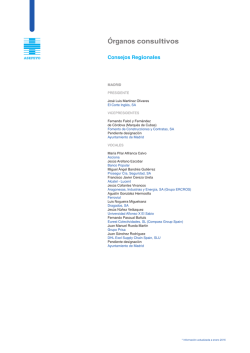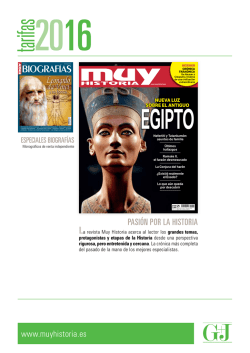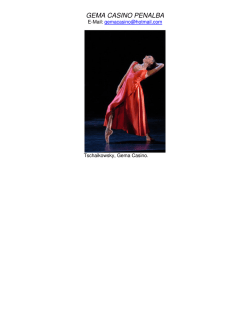
1st IMERP-XIV EJIP - Valencia Interior
1st International Meeting of Early-stage Researchers in Paleontology / XIV Encuentro de Jóvenes Investigadores en Paleontología (1st IMERP-XIV EJIP) 1st IMERP XIV EJIP Un año más y tras 13 ediciones anteriores, se celebra en unos días el Encuentro de Jóvenes Investigadores en Paleontología (EJIP). Tras más de una década el EJIP se ha convertido un importante evento a nivel nacional dirigido a promover la vocación científica entre jóvenes investigadores paleontólogos. Como consecuencia de su consolidación a nivel nacional, el comité organizador de la próxima edición ha decidido darle una mayor difusión al evento, internacionalizándolo bajo el nombre de 1st International Meeting of Early-stage Researchers in Paleontology / XIV Encuentro de Jóvenes Investigadores en Paleontología (1st IMERP-XIV EJIP). Esta nueva edición tendrá lugar en la localidad de Alpuente y estará organizada por un equipo de jóvenes investigadores de diversas instituciones (Universitat de València, España; Museo Paleontológico de Alpuente, España; Museu Valencià d’Història Natural, España; Museo Nacional de Ciencias Naturales; Université de Liège, Bélgica; University of Bristol, Reino Unido y Universidade Federal do Rio de Janeiro, Brazil). El encuentro se desarrollará durante tres jornadas y media de trabajo entre el 13 y el 16 de abril de 2016, incluyendo dos días de discusión donde investigadores de reconocido prestigio internacional realizarán diversas conferencias, y los jóvenes participantes mostrarán sus proyectos e investigaciones. Un punto clave dentro de las jornadas es la de dar a conocer el importante patrimonio paleontológico de la Comunidad Valenciana, para ello se realizarán dos excursiones, una pre y otra post-congreso. Durante el primer día los participantes serán recibidos en Valencia, visitándose el Museo de Ciencias Naturales de la ciudad para conocer la interesante colección ‘Rodrigo Botet’ del cuaternario de Sudamérica, los fósiles de los importantes yacimientos neógenos de nuestra Comunidad o el holotipo del Losillasaurus giganteus, el dinosaurio saurópodo hallado en la localidad de Losilla de Aras (Aras de los Olmos, Valencia) en los años 90. Durante los días 14 y 15 de abril los asistentes finalizarán la jornada con varias visitas guiadas a las instalaciones del Museo de Paleontología de Alpuente, que alberga una de las colecciones de dinosaurios más interesantes de la Comunidad Valenciana. Visitarán el ‘Aula de Recuperación Paleontológica’ así como el yacimiento con huellas de dinosaurio de Corcolilla, declarado BiC. Finalmente, el tercer y último día, se realizará una salida de campo para dar a conocer y poner en valor el patrimonio geológico y paleontológico de la zona, visitando algunos puntos de interés en la comarca del Rincón de Ademuz, entre los que se incluyen un magnífico afloramiento y uno de los mejores escudos coralinos de finales del jurásico a nivel europeo. Se podrán acercar a la localidad de Libros (Teruel), con uno de los mejores yacimientos de preservación excepcional de nuestro país y por último visitarán la localidad de Riodeva (Teruel) donde afloran materiales de la Formación Villar del Arzobispo que han proporcionado fósiles de dinosaurio de gran relevancia internacional. El evento ha sido respaldado por diversas instituciones y entidades, entre ellas la Diputación de Valencia y los Ayuntamientos de Alpuente, La Yesa y Titaguas y está avalado científicamente por instituciones del más alto prestigios como son la IUGS (International Union of Geological Sciences), la SVP (Society of Vertebrate 1st IMERP XIV EJIP Paleontology ), la PalAss (Palaeontological Association), la Sociedad Española de Paleontologia, la Sociedad Geológica de España, el Instituto Geológico y Minero de España o la Fundación Conjunto Paleontológico de Teruel-Dinópolis. Más de 150 participantes procedentes de diversos países: Finlandia, Suecia, Alemania, Polonia, Lituania, Hungría, Italia, Grecia, Australia, China, Canadá, Estados Unidos, Brasil o Argentina, entre otros, que podrán degustar muchos de nuestros productos gastronómicos de los cuales queremos destacar los zumos de manzana esperiega de Ricarda Brun producidos en Ademuz y la cerveza artesana de La Yesa y conocer la gran riqueza paleontológica de nuestras tierras. El evento, al ser de carácter internacional se desarrollará al completo en inglés, dado que es el idioma más extendido en el ámbito de la investigación. Comité organizador: Vicente D. Crespo. Universitat de València (Valencia, Spain). Ana Fagoaga. Universitat de València (Valencia, Spain). Humberto G. Ferrón. Universitat de València (Valencia, Spain). Ignacio García-Sanz. Universitat de València (Valencia, Spain). Borja Holgado. Universidade Federal do Rio de Janeiro (Rio de Janeiro, Brazil). Borja Cascales-Miñana. Université de Liège (Liège, Belgium). Samuel Mansino. Universitat de València (Valencia, Spain). Esther Manzanares. Universitat de València (Valencia, Spain). Rafael Marquina. Museu Valencià d'Història Natural (Alginet, Spain). Carlos Martínez-Pérez. Universitat de València (Valencia, Spain). Maite Suñer. Museo Paleontológico de Alpuente (Alpuente, Spain). Wednesday 13th 12:00-13:15 Reception, early registration and welcome speech by Valencian authorities in the Museo de Ciencias Naturales de Valencia. 13:15-14:00 Guest lecture: Mauricio Antón Project “Visual Paleodiversity” 15:00-17:00 Guided visit to Museo de Ciencias Naturales de Valencia. 17:30 Departure of the coach to Titaguas 19:00-20:00 Early registration in Titaguas 20:00 Welcome speech by local authorities and icebreaker party 1 Thursday 14th Morning Session 9:15-9.30 Official Conference Opening in Casa de la Cultura 9:30-10:15 Guest Lecture (Casa de la Cultura): Christian Klug Paleozoic Marine macroecology Life in Palaeozoic: an overview of land and sea ecosystems Ayuntamiento de Alpuente 10:25-10:40 Using Finite Element Analysis to unravel conodont feeding ecology. Carlos MartínezPérez, Emily J. Rayfield, Héctor Botella and Philip C.J. Donoghue. 10:40-10:55 Computed tomography applied to the study of Leonodus carlsi teeth from the Lower Devonian of Celtiberia (Spain). Alba Martín-Lázaro, Vicent Gisbert-Cardona, Carlos Martínez-Pérez and Héctor Botella. 10:55-11:10 First report of Furongian echinoderms from Spain. Samuel Zamora. Tertiary ecosystems: evolution and palaeoenvironments Casa de la Cultura 10:25-10:40 Dental wear pattern analysis of Stephanomys donnezani (Muridae, Rodentia, Mammalia) from the Pliocene of Layna (Soria).Jessica Acosta-Cabello, Ana R. Gómez-Cano, Paloma López-Guerrero, Iris Menéndez, Mª Ángeles Álvarez-Sierra and Manuel Hernández-Fernández. 10:40-10:55 Miocene (Karpatian) foraminifera from the Central-Paratethys, N-Hungary. Eszter Balassi. 10:55-11:10 The Late Miocene endemic mollusc fauna of the Pannonian Basin (Carpathian region, Central Europe). Dániel Botka and Imre Magyar. 11:10-11:55 Coffe Break 2 Life in Palaeozoic: an overview of land and sea ecosystems Ayuntamiento de Alpuente 11:55-12:10 The Early Devonian Nogueras Flora of the Iberian Peninsula. Borja Cascales-Miñana and Philippe Gerrienne. 12:10-12:25 Trilobites of the Devonian of Portugal – the state of the art. Catarina Caprichoso, Artur A. Sá, Paulo Legoinha and Sofia Pereira. 12:25-12:40 An upper Ordovician benthic assemblage from the Cabeço Pedrogão locality (Central Iberian Zone, Portugal): biostratigraphical and palaeobiogeographical remarks. Jorge Colmenar, Sofia Pereira, A. Sá and Carlos M. da Silva. Tertiary ecosystems: evolution and palaeoenvironments Casa de la Cultura 11:55-12:10 New insights on the Cricetodontini (Cricetidae, Rodentia) from the Middle/Late Miocene of the Duero Basin (Spain): biostratigraphic implications. Arvidas Castillo-Marzo, Paloma López-Guerrero and MªÁngeles Álvarez-Sierra. 12:10-12:25 New Insights on ground beetles (Coleoptera: Carabidae) from Baltic Amber. Sara Gamboa and Vicente M. Ortuño. 12:25-12:40 Preliminary results of a new late Miocene-early Pliocene new site in the Sierra del Colmenar (Bajo Segura Basin, S-E Spain). Arturo Gamonal, Vicente D. Crespo, Samuel Mansino, Rafael Marquina, Hugo Corbí, Jesús Soria, Francisco J. Ruiz-Sánchez and Plini Montoya. 12:45-13:30 Guest Lecture (Casa de la Cultura): James I. Kirkland Utah’s Outstanding Dinosaur Heritage 13:30-15:00 Lunch 3 Thursday 14th Afternoon Session Life in Palaeozoic: an overview of land and sea ecosystems Ayuntamiento de Alpuente 15:00-15:15 Can the semi-erect posture of modern echidna be considered as a proxy for interpreting the posture of early terrestrial tetrapods? Jordi Estefa, Paul Tafforeau, Stephen Wroe, Jozef Klembara, Jocelyn Falconnet, Damien Germain, Per E. Ahlberg and Sophie Sánchez. 15:15-15:30 Palynofacies analysis of the “Kajetanów limestones” (Wuchiapingian, Permian), Poland: preliminary results. Cristiana J. P., Esteves and Hartmut Jäger. 15:30-15:45 Synthesis on the state of “Thuringian” palynological record from the Iberian Peninsula and Balearic islands. Manuel Juncal, José B. Diez, Raúl de la Horra, José López-Gómez, Alfredo Arche and Jean Broutin. 15:45-16:00 Conodonts from the upper part of the Shizhou Member of the Yukiang Formation at Shizhou, Guangxi, South China. Jian-feng Lu, José Ignacio Valenzuela-Ríos, Guo-dun Kuang and Xiuqin Chen. 16:00-16:15 The genus Vysocania Vaněk & Vokáč (Trilobita, Ordovician) – a reappraisal. Sofia Pereira, Petr Budil, Miguel Pires, Artur A. and Carlos M. da Silva. 16:15-16:30 Silurian conodonts of the Obejo-Valsequillo Domain (SW of the Iberian Massif). Pau Aragonés-Illanas, Graciela, N. Sarmiento and Juan Carlos Gutiérrez-Marco. Tertiary ecosystems: evolution and palaeoenvironments Casa de la Cultura 15:00-15:15 Mesowear of Late Miocene large herbivorous mammals from the Pikermian fauna of Greece and Iran: dietary and ecological implications. Tuomas Jokela. 15:15-15:30 A new mortality profile in fossil sites. Iris Menéndez, Ana R. Gómez-Cano and Manuel Hernández-Fernández. 15:30-15:45 Paleoenvironmental changes across the Eocene-Oligocene boundary in the Central Paratethys based on calcareous nannoplankton assemblage. Anita Nyerges and József Pálfy. 15:45-16:00 Rodent fauna from the Early Pliocene site of Baza-1 (Granada, Spain): new data on the biostratigraphy of the Guadix-Baza Basin. Pedro Piñero, Jordi Agustí, Oriol Oms, Sergio RosMontoya, Juan Manuel Jiménez-Arenas and Bienvenido Martínez-Navarro. 4 General Palaeontology Casa de la Cultura 16:00-16:15 The evolution of von economo neurons: a problem among mammalians. Juan P. Berrocal. 16:15-16:30 Social role and resources in palaeontological collections of museums. Sandra Illobre and Margarita Belinchón. 16:30-17:15 Coffe break General Palaeontology Ayuntamiento de Alpuente 17:15-17:30 Extant crocodylians as initial models for the endocast evolution analyses in Eusuchia, and neuroanatomical differences among crocodylia clades. Alejandro Serrano-Martínez, Francisco Ortega and Fabien Knoll. 17:30-17:45 Nature and learning: palaeontology as a pedagogical resource for outdoor education in sciences and mathemathics in fifth grade primary teaching. Marçal Joanes-Rosés and Carlos Martínez-Pérez. 17:45-18:00. Testing the results of digital range of motion by manual manipulation of 3D printed skeletons. Daniel Vidaland Alejandro Serrano-Martínez. General Palaeontology Casa de la Cultura 17:15-17:30 The historical palaeontological collection ‘Sogeresa’ of the Departamento de Geografía, Geología y Medio Ambiente of the Universidad de Alcalá (Alcalá de Henares, Madrid, Spain). Julia Audije-Gil, Fernando Barroso-Barcenilla and Manuel Segura. 17:30-17:45 Dental microwear analysis using light or scanning electron microscopy - A comparison of the methods. Attila Virág and Bence Szabó. 17:45-18:00 Microscopic investigation of bone fossilization in aquatic environments. Marianthi Tzortzi, George Iiopoulos, Ioannis Iliopoulos and Vayia Xanthopoulou. 18:10-18:40 Keynote (Casa de la Cultura): Susan Turner Tracking ‘Gondwanan’ (micro) fish 5 18:40-19:40Guided visit to Alpuente (Palaeontological Museum, restoration room and dinosaur track sites) 19:40 Poster session and beer time (dinner included) in Casa de la Cultura 22:00 Departure to Titaguas Friday 15th Morning Session 9:30-10:00 Keynote(Casa de la Cultura): Fabio Marco Dalla Vecchia Triassic Pterosaurs, the first active vertebrate flyers Palaeobiodiversity and evolution in the Mesozoic world Ayuntamiento de Alpuente 10:10-10:25 A new goniopholidid from the lower Barremian of Galve (Teruel, Spain). Ignacio Arribas. 10:25-10:40 The application of Synchrotron X-Ray tomographic microscopy to the functional study of the conodont skeleton. Hanna Algora, Manuel Rigo, Michele Mazza, Nicolas Goudem and Philip C.J Donoghue and Carlos Martínez-Pérez. 10:40-10:55 Morphological classification of the coprolites from Las Hoyas site (La Huerguina Formation, Cuenca, Spain). Sandra Barrios-de Pedro. 10:55-11:10 Phylogenetic insights of ferns from the Upper Barremian of Las Hoyas (Cuenca, Spain). Candela Blanco-Moreno New insights on Quaternary ecosystems Casa de la Cultura 10:10-10:25 Taphonomic study of micromammal assemblage from level XII at Bolomor Cave (Valencia, Spain). Carolina Aparicio. 10:25-10:40 Relevance of bird migratory species in the Western Palearctic during the PlioPleistocene. Fernando Blanco. 10:40-10:55 Biogeographical patterns of European freshwater gastropods during the Quaternary. Elisavet Georgopoulou, Thomas A. Neubauer, Mathias Harzhauser, Andreas Kroh and Oleg Mandic. 10:55-11:10 Geophagy behaviour related to dietary habits in birds. Francisco Escobar Castro, Jonathan S. Pelegrin and Omid Fesharaki. 6 11:10-11:55 Coffe Break 11:55-12:25Keynote(Casa de la Cultura): Israel M. Sánchez Namibia: Diamonds and Fossils Palaeobiodiversity and evolution in the Mesozoic world Ayuntamiento de Alpuente 12:35-12:50 Study of the pelvis and hind limb of the Allodaposuchidae (Crocodyliformes, Eusuchia) from the Upper Cretaceous of Lo Hueco (Cuenca, Spain) Ane de Celis, Iván Narváez and Francisco Ortega. 12:50-13:05 On the presence of two different taxa of Nothosaurus (Reptilia, Sauropterygia) in the Triassic of the Iberian Peninsula.Carlos de Miguel-Chaves, Soledad García-Gil, Francisco Ortega and Adán Pérez-García. 13:05-13:20 Preliminary palynological analysis in the “Hoces de Beteta” Lower Cretaceous vertebrate sites (Cuenca, Central Spain). Natalia del Pino-Barbero, Fernando Barroso-Barcenilla and Paloma Sevilla-García. 13:20-13:35 A well preserved skull of the crested pterodactyloid pterosaur Anhanguera from the Lower Cretaceous of Brazil. Marco Filippini, Fabio Marco Dalla Vecchia, Barbara Favaretto and Michela Disarò. New insights on Quaternary ecosystems Casa de la Cultura 12:35-12:50 Brown bear (Ursus arctos L.) paleodiet by means of stable isotopes from the Upper Pleistocene and Holocene of the NW of the Iberian Peninsula. Ana García-Vázquez, Ana C. PintoLlona and Aurora Grandal-d’Anglade. 12:50-13:05 Influence of growth and trophic level in bone collagen stable isotopes of Ursus arctos from Pyrenees (Spain). Ana García-Vázquez, Victor Sauqué, Raquel Rabal-Garcés, Ricardo GarcíaGonzález, Gloria Cuenca-Bescós and Aurora Grandal-d’Anglade. 13:05-13:20 Large mammals from the Mousterian (Late Pleistocene) Cave of Abauntz (Arraitz, Navarra). Víctor Jerjo-Toma, Gloria Cuenca-Bescós, Carlos Mazo and Pilar Utrilla. 13:20-13:35 Palaeoecological inferences on the Pleistocene deposits of Charadros River (Sichena, NW Peloponnesus, Greece). Maria Tsoni. 13:35-15:00 Lunch 7 Friday 15th Afternoon Session Palaeobiodiversity and evolution in the Mesozoic world Ayuntamiento de Alpuente 15:00-15:15 Histology of the skull and pectoral girdle in Metoposaurus krasiejowensis (Amphibia, Temnospondyli) from the Upper Triassic of Poland. Kamil Gruntmejer, Elżbieta M. Teschner and Dorota Konietzko-Meier. 15:15-15:30 First palynological datation of the Triassic Eslida Formation (Buntsandstein facies in the SE Iberian Ranges).Manuel Juncal, José B. Diez, Raúl de la Horra, Belén Galán-Abellán, Violeta Borruel-Abadía, José López-Gómez, and Alfredo Arche. 15:30-15:45 Conodonts from the area of Budapest (Hungary): key elements for Middle Norian conodont zonation? Viktor Karádi. 15:45-16:00 The record of Thalassinoides-bearing deposits at the Lower Toarcian (Lower Jurassic) of the Fonte Coberta section (NW, Portugal).Olmo Míguez-Salas, Francisco Javier Rodríguez-Tovar and Luís Vítor-Duarte. 16:00-16:15 Late Jurassic sauropod teeth from the Lusitanian Basin. Pedro Mocho, Rafael-RoyoTorres and Francisco Ortega. 16:15-16:30 A horseshoe crab hot spot in the Early Triassic of the Catalan Pyrenees (NE Iberian Peninsula): a preliminary ichnological study. Eudald Mujal, Zain Belaústegui, Josep Fortuny, ArnauBolet, Oriol Oms and José Ángel López. 16:30-16:45 Taphonomic approach to the vertebrate remains of the “Hoces de Beteta” Lower Cretaceous sites (Cuenca, Central Spain). Irene Prieto Saiz, Fernando Barroso-Barcenilla, Óscar Cambra-Moo and Paloma Sevilla-García. 16:45-17:00 Late Cretaceous Vertebrate Coprolites from Iharkút (Western Hungary) and their paleoecological significance. Martin Segesdi, Attila Ősi, Krisztina Buczkó, Emese Réka Bodor and Zsolt Dallos. New insights on Quaternary ecosystems Casa de la Cultura 15:00-15:15 Small vertebrates and reconstruction of Pleistocene habitats in the Baranica Cave (Eastern Serbia). Mihailo Jovanović, Dragana Đurić and Katarina Bogićević. 15:15-15:30 Structure and composition of tooth enamel in Quaternary soricines (Mammalia) from Spain. Raquel Moya-Costa, Gloria Cuenca-Bescós, Blanca Bauluz and Juan Rofes. 8 15:30-15:45 Turnover in dominant suid lineages in Turkana Basin area 2 Ma ago. Janina Rannikko, Indre Zliobaite and Mikael Fortelius. 15:45-16:00 Paleontological data about the small-mammals assemblage from the Late Pleistocene of Kaldar Cave (Khorramabad Valley, Iran). Iván Rey-Rodríguez, Juan Manuel López-García, Hugues-Alexandre Blain, Mónica Fernández-García, Laxmi Tumung, Xosé Pedro Rodríguez-Álvarez, Andreu Ollé and Behrouz Bazgir. 16:00-16:15 Palaeoecological analysis of Late Pliocene and Pleistocene cervids from Hungary. Bence Szabó and Attila Virág. 16:15-16:30 Galician aurochs: a morphologic, metric and isotopic study. Amalia Vidal-Gorosquieta, Aurora Grandal-d´Anglade, Marcos Vaqueiro-Rodríguez and Juan Ramón Vidal-Romaní. 16:30-16:45 Portalón del Tejadilla: new contributions to the ecosystems of the Castilian plateau during the Late Pleistocene. Alicia Sanz, Nohemi Sala, Milagros Algaba and Juan Luis Arsuaga. 16:45-17:00 Palaeophytogeography of Castanea sativa Mill. during the Quaternary in Central Spain.Sandra Robles-López1, Sebastián Pérez-Díaz and José Antonio López-Sáez 17:00-17:45 Poster session and coffee break 17:45-17:55 Presentation of the new Master in Paleontology of the UV 17:55-18:05 Presentation of Transmitting Science specialized postgraduate courses and workshops. Soledad de Esteban-Trivingo. 18:05-18:15 Presentation of the Paleontological Spanish Society news. 18:15-19:00 Guest Lecture (Casa de la Cultura): Marc Furió Plio-Pleistocene shrews (Soricidae, Mammalia): palaeobiology, biostratigraphy and climaticforced extinctions in Europe. 19:00-19:15IMERP-EJIP Closure, including future proposals. 19:15-20:00 Guided visit to Alpuente (Palaeontological Museum, restoration room and dinosaur track sites). 21:30 Closure dinner and Disco. 9
© Copyright 2026


